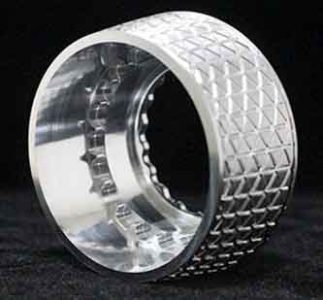Er zijn veel redenen voor de vervorming van onderdelen van aluminiumlegeringen tijdens CNC-bewerking, en de bedieningsmethode is ook een van de redenen bij de daadwerkelijke bediening. Volgende, de CNC-bewerkingsfabrikant van onderdelen van aluminiumlegeringen zal kort de operationele vaardigheden van de verwerking van onderdelen van aluminiumlegeringen introduceren.
(1) For parts with large milling allowances, in order to have better heat dissipation conditions during processing and avoid heat concentration, symmetrical processing should be used during processing. Als er een aluminiumplaat van 90 mm dik is, moet deze tot 60 mm worden bewerkt, if the other side is milled immediately after milling all the margins on one side, and the final size is processed at one time, the flatness can only reach 5mm; If symmetrical processing with repeated feeds on two sides is used, Elke zijde wordt tweemaal verwerkt tot de uiteindelijke grootte, which can ensure a flatness of 0.3mm.
(2) Verminder de snijkracht en snijd het vuur door de snijhoeveelheid te veranderen. Onder de drie elementen van het snijvolume, Het snijden van de dikte heeft een grote invloed op de snijkracht. If the milling allowance is too large, De snijkracht van één pass is te groot, die niet alleen de onderdelen zullen vervormen, maar beïnvloedt ook de stijfheid van de machine -gereedschapsspil en verminder de duurzaamheid van het gereedschap. Als de snij dikte wordt verminderd, De productie -efficiëntie zal sterk worden verminderd. Echter, high-speed milling is used in CNC machining, which can overcome this problem. Terwijl de snijdikte wordt verminderd, Zolang de feed dienovereenkomstig wordt verhoogd en de snelheid van het machine -gereedschap wordt verhoogd, De snijkracht kan worden verminderd en tegelijkertijd de verwerkingsefficiëntie wordt gewaarborgd.
(3) If there are multiple cavities on the aluminum plate part, Het is niet raadzaam om een sequentiële verwerkingsmethode voor de holte te gebruiken tijdens de verwerking, as this will easily cause uneven stress and deformation of the parts. Multi-layer verwerking wordt aangenomen, en elke laag wordt zoveel mogelijk naar alle holten verwerkt, En dan wordt de volgende laag verwerkt om de onderdelen gelijkmatig gestrest te maken en vervorming te verminderen.
4) The thin-walled aluminum alloy workpiece is deformed due to the clamping of the fixture during CNC machining. Even finishing is unavoidable. Om de vervorming van het werkstuk te minimaliseren, you can loosen the clamp before the finishing process reaches the final size, so that the workpiece can be restored to its original shape freely. Then lightly compress it to the extent that it can just clamp the workpiece, zodat het ideale verwerkingseffect kan worden verkregen. In het kort, Het punt van werking van de klemkracht is het beste op het ondersteunende oppervlak, and the clamping force should act in the direction where the rigidity of the workpiece is good. Under the premise of ensuring that the workpiece does not loosen, Hoe kleiner de klemkracht, des te beter.
(5) The CNC cutting sequence should also be paid attention to. Ruwe bewerking benadrukt de verbetering van de bewerkingsefficiëntie en het nastreven van verwijderingssnelheid per tijdseenheid. Rough machining can generally be upside milling. Dat is, Het overtollige materiaal op het oppervlak van de blanco wordt met de snelste snelheid en de kortste tijd verwijderd, en de geometrische contour vereist voor afwerking is in principe gevormd. De nadruk van afwerking is een hoge precisie en hoge kwaliteit, so down milling should be used. Omdat de snij dikte van de snijtanden geleidelijk afneemt van het maximum naar nul tijdens het frezen, De mate van werkharden is sterk verminderd, en op hetzelfde moment, the degree of deformation of the parts is reduced.
(6) When CNC machining aluminum parts with cavities, try not to let the milling cutter plunge directly into the part like a drill. This leads to insufficient chip holding space of the milling cutter, unsmooth chip removal, and unfavorable phenomena such as parts overheating, uitbreiding, tool collapse, and tool breakage. Eerst, drill the hole with a milling cutter of the same size as the milling cutter or one size larger, and then use the milling cutter to mill. alternatief, De CAM -software kan worden gebruikt om het spiraalvormige snijprogramma te produceren.

Draai- en freesvaardigheden van onderdelen van aluminiumlegeringen
 English
English العربية
العربية 中文(漢字)
中文(漢字) Čeština
Čeština Dansk
Dansk Nederlands
Nederlands Suomi
Suomi Français
Français Deutsch
Deutsch Italiano
Italiano 日本語
日本語 ಕನ್ನಡ
ಕನ್ನಡ 한국어
한국어 Português
Português Русский
Русский Slovenčina
Slovenčina Español
Español Svenska
Svenska Türkçe
Türkçe

